-
What is the Model Context Protocol (MCP)?
Tool calling and agentic workflows Agentic systems and workflows are a hot topic in the LLM field as they help take automation efficiency with LLMs to the next level. One of the factors that makes …

-
Function calling in LLM agents
This post provides the basics to help understand function calling in LLMs, a key capability that enables LLM agents to automate complex workflows. What is function calling in LLM agents? Examples …

-
OpenAI: GPT-4.1 Nano is the best LLM for Rust coding 👑 (Deep dives from the DevQualityEval v1.1)
The most capable model for Rust is OpenAI: ChatGPT-4o, with GPT-4.1 Nano being the most cost-efficient choice. DeepSeek: DeepSeek V3 is the best open-weight model and Google: Gemma 3 (both 12B and …
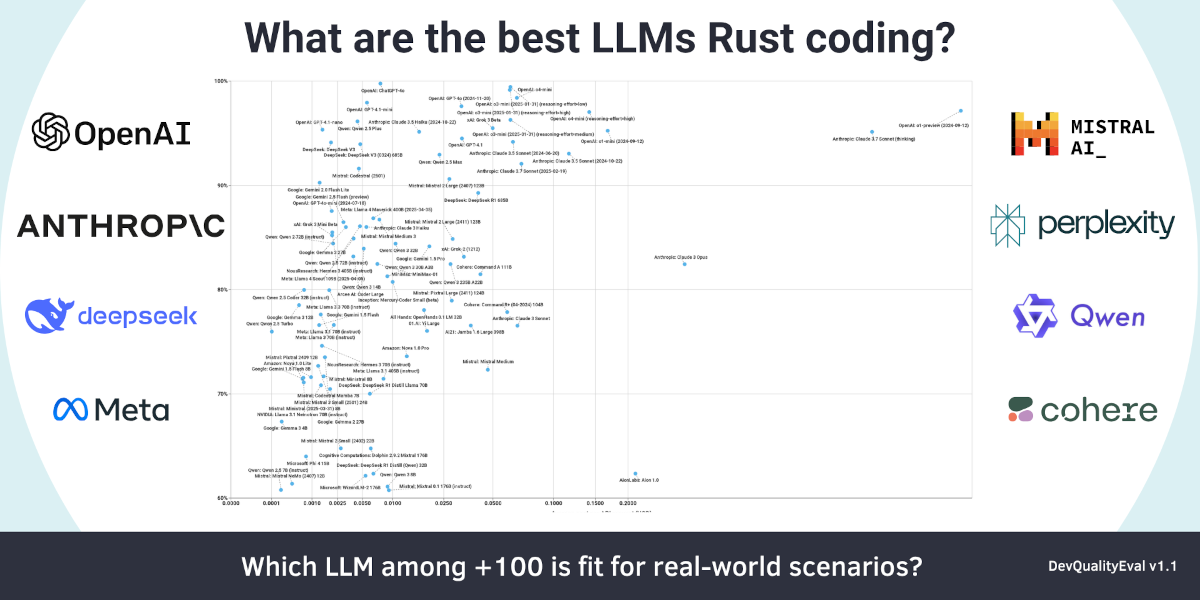
-
Benchmarks evaluating LLM agents for software development
This post provides an overview of the most useful benchmarks for evaluating LLM code generation agents and agentic software development workflows. Table of contents: LLMs vs LLM agents Challenges …

-
An introduction to LLM agents for software development
In this post, we cover the basics of using agentic workflows and LLM coding agent tools for software engineering. Read on for an introduction to agents and their capabilities, their limitations, and …

-
How well can coding agents be installed with a good cheap model, transpile a repository, and then generate & execute tests?
In this blog post, we are test-driving all major coding agents (aka. software engineering agents). We want to answer the following questions: Can the agent be used purely in the CLI, without any …

-
Anthropic's Claude 3.7 Sonnet is the new king 👑 of code generation (but only with help), and DeepSeek R1 disappoints (Deep dives from the DevQualityEval v1.0)
This deep dive takes a look at the results of the DevQualityEval v1.0 which analyzed 107 different LLMs for generating quality code (for Java, Go and Ruby). Anthropic’s Claude 3.5 Sonnet …

-
Tools for JUnit 4 to 5 migration
The process of upgrading from JUnit 4 to 5 requires you to update annotations, assertions, assumptions, dependencies, etc. There are several tools out there to (semi-) automate the upgrade process. …

-
OpenAI's o1-preview is the king 👑 of code generation but is super slow and expensive (Deep dives from the DevQualityEval v0.6)
This deep dive takes a look at the results of the DevQualityEval v0.6 which analyzed over 80 different LLMs for generating quality code (for Java, Go and Ruby). OpenAI’s o1-preview and …

-
JDK 23: What is new in Java 23?
We provide an overview and details about the features delivered in Java 23 (JDK 23) released on 17 September 2024. Read the post to learn about what is new in Java 23 and why these new and updated …

-
Test impact analysis: Automatically run affected tests only
Test impact analysis identifies tests affected by code changes to save time on test execution. Even a basic implementation leads to a 29% reduction in test execution times on average, showcased here …

-
LLM cost management: how to reduce LLM spending?
We cover the strategies that help you control costs when using Large Language Models to generate text or software code. Integrating LLMs into your workflow can open up a wide range of use cases …

-
LLM observability: tools for monitoring Large Language Models
Observability helps monitor the operation of LLM-based systems. The following tools and techniques can be used to track the resources and behavior of Large Language Models (LLMs) used in production. …

-
Transpiling Go & Java to Ruby using GPT-4o & Claude 3.5 Sonnet
The project was to extend our DevQualityEval LLM code generation benchmark with a new language: Ruby. We successfully used LLMs to transpile existing Java and Go code (tasks and test cases) to Ruby. …

-
Using Aider AI for code generation
This post covers the use of Aider, a generative LLM-powered software engineering tool, to generate software code. 🦾 Better LLMs for software development Symflower helps you build better software by …

-
The best LLM tools for software development
This post provides an overview of the various LLM-based generative development tools available out there. Are we missing an AI tool for coding? Let us know! Large Language Models are now advanced …

-
Comparing LLM benchmarks for software development
This post compares the various benchmarks that help rank large language models for software development tasks. 💡 A blog post series on LLM benchmarking Read all the other posts in …

-
What are the most popular LLM benchmarks?
This post covers the most widely used benchmarks for assessing the performance of large language models. Table of contents: Why use benchmarks for LLM evaluation? The best LLM benchmarks …

-
Evaluating LLMs: complex scorers and evaluation frameworks
This post details the complex statistical and domain-specific scorers that you can use to evaluate the performance of large language models. It also covers the most widely used LLM evaluation …

-
DeepSeek v2 Coder and Claude 3.5 Sonnet are more cost-effective at code generation than GPT-4o! (Deep dives from the DevQualityEval v0.5.0)
This deep dive takes a look at the results of the DevQualityEval v0.5.0 which analyzed over 180 different LLMs for code generation (Java and Go). DeepSeek Coder 2 took LLama 3’s throne of …

-
How does LLM benchmarking work? An introduction to evaluating models
Part 1 of our LLM evaluation series covers the basics of LLM evaluation including popular benchmarks and their metrics. With the (generative) AI revolution raging full steam ahead, new large …

-
How to write reusable code? Guide & best practices for reusability in Java
In this post, we dive into code reuse and some key code reusability best practices that help you optimize Java code for reuse. What is code reusability? Not all code is one of a kind, highly …

-
Analyzing application performance: A guide to manual instrumentation with Go tracing
In this post, we look at Go tracing and its support to manually instrument applications to gain valuable insights into its execution behavior. We’ll be using a simple step-by-step example …

-
How to reproduce and find fixes for reported software errors?
This post walks you through our approach to addressing reported software problems with Symflower. Check out this blog post about categorizing software problems with stack traces and code diffs to …

-
What are Java modules and how to use them?
In this post, we dive into the details of modules in Java, covering the most important types and their differences. What are modules in Java? Modules are used to create separate units of software …

-
Generating test templates for 10 open-source Spring Boot applications with Symflower
In this post, we evaluate test template generation with Symflower in real-life, large-scale Spring Boot projects. See how we tested Symflower on 10 applications and check out the results. Developing …

-
A guide to test data initialization
In this post, we cover the three key ways of initializing test data for your unit tests: direct initialization, the Object Mother pattern, and the Test Data Builder pattern. When testing to ensure …

-
Is Llama-3 better than GPT-4 for generating tests? And other deep dives of the DevQualityEval v0.4.0
This deep dive takes a look at the results of the DevQualityEval v0.4.0 which analyzed 138 different LLMs for code generation (Java and Go). LLama 3 is gearing up to take GPT-4’s throne, the …

-
From bug detection to resolution: Categorizing software problems with stack traces and code diffs
This blog post showcases Symflower’s automatic error reporting process, which involves a novel approach to categorizing huge amounts of software problems by combining stack traces and code …

-
Can LLMs test a Go function that does nothing?
In this article we are looking at an evaluation of 123 LLMs on how well they can write automated tests for an empty Go function. What code generation abilities do these LLMs already have? Which …

-
What is the difference between @Controller vs @RestController in Spring Boot?
This post covers the use of controllers in Spring Boot and describes the differences between the @Controller and @RestController annotations. Table of contents: What are controllers in Spring Boot? …

-
A beginner's guide to unit testing 4/4: Unit testing best practices
In part 4 of our guide to unit testing, we list a few of the most important best practices for writing effective unit tests. Unit tests are a powerful tool to enhance the robustness of your code. …

-
A beginner's guide to unit testing 3/4: Automating unit tests
Part 3 of our introduction to unit testing tackles the topic of automating unit tests in your application development workflow. In our series about unit testing, we’ve already covered what …

-
A beginner's guide to unit testing 2/4: How to use unit tests?
Part 2 of our introduction to unit testing covers how to write unit tests and presents some unit testing tools for Java. Unit tests form a core practice of software development, but not all …

-
A beginner's guide to unit testing 1/4: What is unit testing?
In part 1/4 of our new series on unit testing, we’re tackling the basics of what unit testing is and why it should be used. Unit testing is (or rather, should be) a core practice for any …

-
Spring Web MVC vs Spring WebFlux: differences between Spring web frameworks
In this post, we dive into the many differences between Spring Web MVC and Spring WebFlux to help you determine which one to use for your project. Table of contents: What is Spring Web MVC? What is …

-
The best static analysis tools and linters for Java
This post covers static analysis tools for Java, with a list of some of the best linters and other static analysis tools for Java. Table of contents: What is static code analysis? What’s …

-
Spring Boot folder structure best practices
This post covers the various aspects of creating a folder structure for your Spring Boot projects that is logical and easy to navigate for other members of your team. Table of contents: Key …

-
JUnit testing tips and tricks 3/3: Changing test execution order in JUnit 4 & JUnit 5
Using JUnit for your daily unit testing? Part 3 of our series on JUnit tips and tricks covers specifying a sequence for your tests to be executed in. In part 1 of this series, we showed how to …

-
JUnit testing tips and tricks 2/3: Tagging and filtering test cases in JUnit 4 & JUnit 5
In part 2 of our series on JUnit testing tips and tricks, we cover the topic of tagging and filtering test cases in both JUnit 4 and JUnit 5. In the first part of this series, we covered how to …

-
How to do mocking in Spring Boot? Best practices for using @MockBean vs @Mock
In this post, we’ll cover the basics of mocking objects when unit testing Spring Boot applications with examples. Check out all the other parts of our blog post series on Spring Boot: …

-
JDK 22: What is new in Java 22?
JDK 22 was released on 19 March 2024. This post provides a quick look at all the features we are excited about in Java 22. Java’s previous version JDK 21 (LTS) was released on 19 September …

-
JUnit testing tips and tricks 1/3: How to ignore test cases in JUnit 4 and 5?
Part 1 of our series on JUnit testing tips and tricks is about ignoring test cases in JUnit 4 and JUnit 5. JUnit is the most popular testing framework used by thousands of developers. If …

-
An introduction to Spring Boot: the basics
Heard all the good things about Spring Boot but not quite sure what it’s all about? It’s OK, we’ve got you covered: this post is your fundamental guide to Spring Boot! …

-
Security testing tools and techniques
Security testing is becoming a crucial part of software development. This post covers the fundamental techniques and tools that software developers can rely on. With cyberattacks on the news …

-
2024 Software testing trends to watch out for
Software testing is changing. Learn about the next evolutionary steps we expect to see in 2024 in the world of Quality Assurance! Look back at 2023 and you’ll see that this past year has …

-
Mocking frameworks for Java: Mockito vs EasyMock vs JMockit
There are various mocking frameworks for Java developers out there. In this post, we compare Mockito, EasyMock, and JMockit with a Java example to help you pick the right one for your needs! What is …

-
JetBrains Aqua: an IDE for test automation
JetBrains Aqua is the IntelliJ IDE for test automation Quality Assurance specialists. Here’s what you need to know about this new IDE! Released in 2022, JetBrains Aqua is a new standalone …

-
Chaos engineering 101 & Best practices for chaos testing
In this blog post, we dive into the topic of chaos engineering for testing the resilience of software products. Our series about the software testing jungle introduced the basic categories of …

-
Spring framework basics: Spring vs Spring Boot vs Spring Web MVC vs Spring WebFlux
Those new to the Spring ecosystem can easily get confused about the differences between Spring, Spring Boot, Spring Web MVC, and Spring WebFlux. In this post, we clear it all up! A guide to the …

-
Symbolic execution vs fuzzing for creating test values
Automatically generating values for unit testing can be a huge time-saver. This post features a comparison of two alternative strategies for generating test values: fuzzing and symbolic execution. …

-
Code generation with Symflower & GitHub Copilot: AI vs Symbolic Execution for Software Testing
This post takes a look at two incredibly useful tools that transform the way software developers work. Read on to find out about the background and use of GitHub Copilot and Symflower for software …

-
Java Unit Testing Frameworks Compared: JUnit vs TestNG differences and similarities
JUnit and TestNG are the most popular unit testing frameworks for Java code. This post provides an overview of their similarities and differences. While they are the most well-known frameworks for …

-
Spring Boot testing best practices & guide
Spring Boot is the most popular application framework out there. This guide provides best practices to help test your Spring Boot applications! What is Spring Boot? Spring Boot is a …

-
How to test your tests? A guide to mutation testing & mutation testing tools
Mutation testing (an error-based testing technique / fault-based testing technique) is a lesser-used technique to help ensure high software quality. This post provides an introduction to mutation …

-
JDK 21: What is new in Java 21?
JDK 21 is here! This article details all the updates and changes in the latest version Java 21 with quick descriptions and examples to help you understand what is new. The previous JDK version, Java …

-
Insights from the State of Testing report 2023
This post analyzes the findings of the State of Testing™ Report’s 2023 edition with all the key trends, practices, and challenges in software testing relevant now and in the near future. …

-
What is the testing trophy and how does it help better test software?
The software testing trophy is a lesser-known alternative to the popular testing pyramid. This post dives into the details of the testing trophy and its differences to the testing pyramid. As we …

-
How to split a commit with Git?
At Symflower we love rebasing commits. This is not a result of us enjoying the suffering of our team members that are not yet fluent with Git, but it makes development, debugging problems and …

-
Software testing basics: unit testing vs integration testing
Unit testing and integration testing are both indispensable in software quality assurance. This post covers the basics of both types of testing and introduces a useful tool to automate your testing …

-
Programming principle "KISS": Keep it simple, stupid!
KISS (aka Keep it Simple, Stupid!) is a handy principle for anyone designing complex systems such as software. This post dives into how you can apply it in your projects! In our series about …

-
How to migrate from JUnit 4 to JUnit 5: a step-by-step guide
This step-by-step guide walks you through the JUnit 5 upgrade process to help you migrate from JUnit 4 to JUnit 5. For a fully automated solution, you can use Symflower to handle the entire …

-
What is the cost of missing tests? Part 4: Reduced confidence
Inadequate software testing has many drawbacks such as the risk of bugs and errors, increased development time, and growing technical debt – all covered in previous parts of this series. In this …

-
Using code katas to become a better software developer
Many software developers use coding katas to get better at writing efficient and high-quality code. This post dives into the details of code kata exercises and how they can help enhance your coding. …

-
Debugging part 4: Finding simple reproducers during debugging with Symflower
In this final article of our 4-part series on debugging, we’ll walk you through a practical example of using Symflower to find simple reproducers for bugs in your code. This blog series on …

-
How to introduce TDD in your organization?
Test-Driven Development promises significant benefits, but its adoption is far from straightforward. In this post, we’re sharing some best practices and strategies to ensure the success of …

-
What is the cost of missing tests? Part 3: Growing technical debt
As many teams know, skipping adequate testing can result in growing technical debt. That’s what we dive into in part 3 of our series on the costs of missing software tests. In previous …

-
How to get started with Test-Driven Development
Test-Driven Development (TDD) is gaining traction in the industry. This blog post introduces our white paper which helps you and your team get familiar with TDD. The post also mentions some of the …

-
What is the cost of missing tests? Part 2: Increased development time
Inadequate software testing is known to result in longer development times, leading to delays in time to market. That’s what we dive into in this article, part 2 of our series on the costs …

-
Debugging part 3: Using unit tests to debug software applications
This guide to using unit tests to find and fix bugs in software applications is part 3 of our debugging series, focusing on the practical side of debugging. In part 1 of this series, we gave a …

-
What are the top Java unit testing frameworks & tools in 2024?
There are some widely used unit testing frameworks and useful tools that can greatly support your unit testing efforts. Here’s a top list of the ones we find best! Most developers today …

-
What is the cost of missing tests? Part 1: Bugs and errors
Missing or skipping adequate testing can lead to risks that could endanger the success of any software project. But what exactly are the specific and practical drawbacks of poor software quality due …

-
Debugging part 2: Tools and approaches for debugging
In part 2 of our post series on debugging, we’re covering the practical aspect, providing some useful workflows and tools that you can use to put the TRAFFIC principle into action when …

-
The best IntelliJ IDEA productivity plugins for Java developers
In this post, we list the most useful IntelliJ productivity extensions for Java developers. Table of contents: IntelliJ & Java IntelliJ plugins to boost Java development productivity …

-
How to run JUnit 5 tests with Gradle: a step-by-step guide
This guide provides instructions for setting up your system to run JUnit tests with Gradle. Table of contents: Running JUnit 5 tests with Gradle What is Gradle? How to set up your project to run …

-
TreeSitter - the holy grail of parsing source code
As a software analysis company we have an inherent need for parsing source code. Until recently we used the maybe most prominent tool for parsing Java code which is JavaParser. JavaParser works …

-
Debugging part 1: A guide to fixing bugs in software applications with the TRAFFIC principle
Debugging a piece of software can drive the most well-tempered developer nuts – yet, sadly, it’s also inevitable, as no one writes bug-free code. Trying to find out what is wrong with …

-
A more robust way to install VS Code for extension testing
Check out all the posts in our VS Code extension development series: How to make VS Code extensions: guide & best practices Through testing our VS Code extension – Symflower for VS Code – …

-
How to write JUnit test cases: advanced techniques
Part 2 of our guide to unit testing with JUnit covers advanced techniques for staying efficient when applying JUnit 5 unit tests in your projects. 💡 A series on JUnit testing Part 1: How to write …

-
Modifying a VS Code installation in extension tests
Check out all the posts in our VS Code extension development series: How to make VS Code extensions: guide & best practices The starter template for VS Code extensions gives you a lot of …

-
Generating unit tests for Java projects with Maven dependencies
Symflower allows you to analyze and automatically generate unit tests for Java projects which rely on Maven dependencies. Let us have a look at how that plays out in practice. Project Setup We are …

-
Timeout-based checks in VS Code extension tests
Check out all the posts in our VS Code extension development series: How to make VS Code extensions: guide & best practices When testing VS Code extensions, you might run into scenarios …

-
How to write JUnit test cases? A step-by-step guide with examples
This is part 1 of our guide to unit testing with JUnit which covers the basics with Java unit test examples and best practices for writing JUnit test cases. 💡 A series on JUnit testing Part 2: …

-
How to write VS Code extensions: guide & best practices
Aiming to get started with plugin development for Visual Studio Code? You’re in the right place to kick things off! This series of blog posts will provide you with fundamental information …

-
A better X server setup for IntelliJ plugin tests locally and in your CI
Check out all the posts in our IntelliJ plugin development series: All you need to know for IntelliJ plugin development When you test an IntelliJ plugin using UI automation, you need to have an …

-
Testing IntelliJ plugins on Windows in your CI using GitLab Runner
Check out all the posts in our IntelliJ plugin development series: All you need to know for IntelliJ plugin development At Symflower, we subject all of our software components to mandatory …

-
Smart Java Unit Test Generation for VS Code and IntelliJ
Performing unit testing has become standard practice in modern software development. Doing adequate unit testing is simply necessary if you’re aiming to shift-left your testing and fix …

-
Isolating IntelliJ plugin tests using temporary project directories
Check out all the posts in our IntelliJ plugin development series: All you need to know for IntelliJ plugin development When testing a plugin for IntelliJ-based IDEs using a UI test, the plugin …

-
Accessing IntelliJ plugin classes in UI tests
Check out all the posts in our IntelliJ plugin development series: All you need to know for IntelliJ plugin development When testing an IntelliJ plugin, you’ll likely reach for UI tests …

-
Tutorial: all you need to know for IntelliJ plugin development
So you’re interested in plugin development for a Jetbrains' IntelliJ-based IDE such as IntelliJ IDEA, GoLand, or Android Studio. You’ve come to the right place! Our blog post …

-
JDK 20: What is new in Java 20?
Java 20 has been released on 21st March 2023, and it introduced a range of changes and new functionality. The current version is a non-LTS release, while the following version 21 is set to be a …

-
Create JUnit tests more productively with Symflower
Symflower fully supports you when writing Java tests with JUnit 4 and JUnit 5. There are two ways to use Symflower to streamline your unit testing activities: Instantly generate boilerplate testing …

-
Software development trends for 2023
Software development has to evolve to keep pace with the growing demand for digital technologies and the software that drives them. Here’s a list of trends that define software development …

-
LSP in VS Code: integrating a language server in a Visual Studio Code extension
Check out all the posts in our VS Code extension development series: How to make VS Code extensions: guide & best practices If you’re working on developer assistance tooling such …

-
Software testing trends for 2023
Here’s a list of new software testing strategies that will likely gain traction in 2023, and the software testing trends that Symflower expects to continue to unfold this year! With …

-
Incremental development with short iterations for more productivity and less frustration
Implementing new features and thinking up the best way to get everything just right is part of what makes software development exciting. In addition, being able to apply our problem solving skills …

-
Programming principle "YAGNI": you ain't gonna need it
The programming principle YAGNI (You aren’t gonna need it) originates from extreme programming, which is an agile software development methodology that advocates frequent releases with …

-
Java Fuzzing with Jazzer compared to Symflower
Fuzzing is a testing technique where random values are generated as inputs to find unexpected behavior such as crashes and security issues. Previously we looked at the new Golang release 1.18 which …
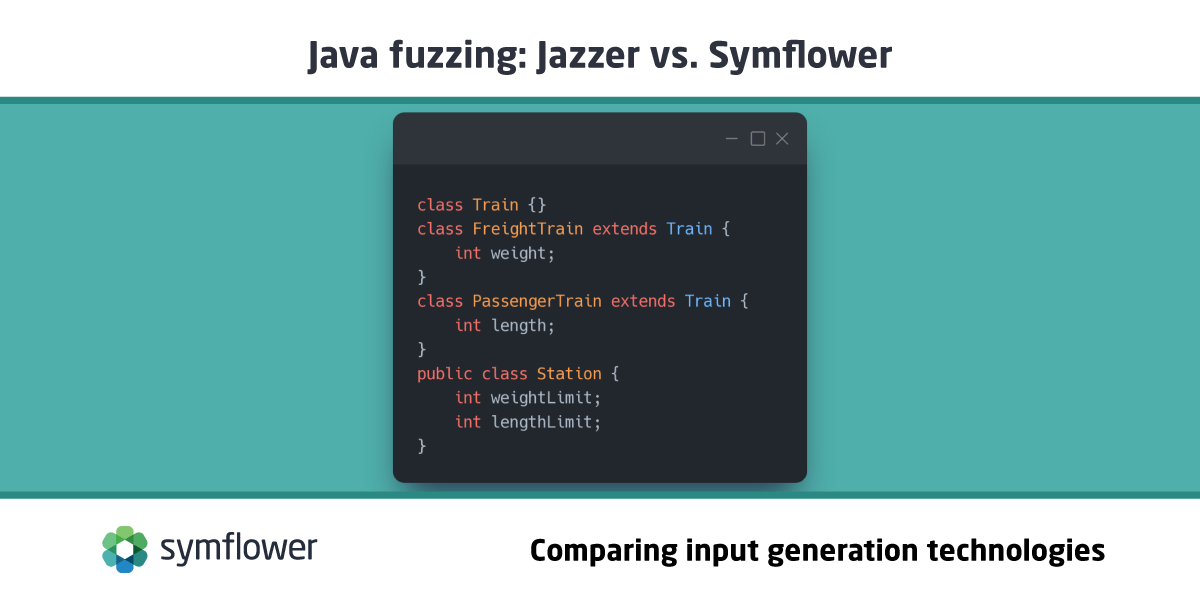
-
Getting started with plugin development for JetBrains IDEs like IntelliJ, Goland, and Android Studio
Check out all the posts in our IntelliJ plugin development series: All you need to know for IntelliJ plugin development No matter what your technical background as a developer looks like, …

-
Reusing a software development workflow for creative work
Creating illustrations on conceptual issues is a very tedious task which is often required when working on a product for software developers. Though tedious, illustrating those abstract concepts …

-
What is the testing pyramid and how to use it? [+Example]
In the software world we have an ever growing collection of testing technologies at our disposal. Mainly there are three levels on which testing is commonly performed: the unit-, integration- and …

-
Rapidly write tests in IntelliJ IDEA and Goland with test templates
Test templates help you write and maintain manually-written unit tests more easily and quicker than doing it entirely by hand. The test template generator in our IntelliJ plugin takes care of …

-
The software testing jungle
There are hundreds of different kinds of software testing types around. Why is that? Because every functional and non-functional requirement of a software product needs to be tested, otherwise one …

-
Review generated unit tests, instead of writing them by hand
Unit tests are essential for fast but safe development. They freeze intended behavior, and therefore let us find bugs due to changes or refactoring hiccups with ease. This saves us a lot of time …

-
The essential guide for SEO using meta tags
Why should you care about meta tags? Well, meta tags help ensure your website works as intended. They present your page in the optimal way to search engines and social media websites, thus helping …

-
Using custom CSS to change websites to your desires
Do you have a website or web application that would be more readable if the style would just change a little bit? We faced the same problem at Symflower with GitLab because the names of our CI jobs …

-
Programming principle "DRY": Don't Repeat Yourself
This article offers a fresh perspective on the programming principle Don’t Repeat Yourself (DRY) and showcases how we embrace DRY internally at Symflower. DRY is most commonly applied in …

-
Switch between unit test styles of Go and Java
Have you ever asked yourself how to name and structure your automated tests, which assertions you should use and how to implement sub-tests? The answers to these questions make up your test style. …

-
Best practices for Java and Go unit tests: naming conventions and structure
When applying unit testing on your software, you’ll likely end up with lots of unit tests. In order to stay organized so that your test package structure is transparent and easy for other …

-
Programming principle "Chesterton's Fence": Understand the current state before changing it
Programming principles (also called coding principles or conventions) are guidelines that help us prevent making “unfavorable” design decisions during coding. That is why every …

-
Java unit test templates: Reducing boilerplate code
Unit tests are not just a nice-to-have, but a must-have in most projects. They let you focus on your implementation as the existing behavior can be freezed with a good unit test suite, that is, …

-
A COMPLETE guide on how to make Docker images even smaller
These days everything is either moving or already running in containers when it comes to software infrastructure. The very first container of Symflower was not for our product, some service or our …

-
How to auto-generate advanced forms using Formly
Nearly every programmer has experienced long and confusing code at least once in their lives. Such complexity often happens naturally during development, by adding new code to improve the product. …

-
Writing better table-driven tests: pros and cons of different unit testing styles
Ever wondered what the best style for writing unit tests is? We at Symflower have a certain take on that. We developed a test style optimized towards debuggability, readability and …

-
How real-time autonomous unit testing can help you develop better software
Having to deal with code quality issues deep in a project’s life-cycle is a shared nightmare between all developers. There is nothing worse than being knee-deep in development – or, in a …

-
Getting started with Visual Studio Code extension development
Most developers have used Visual Studio Code at some point in their careers. It has been voted the most popular IDE of 2021 by respondents of the StackOverflow developer survey, and its appeal is …

-
Methods for automated test value generation
In the first blog post of our blog series on Symflower’s Core Technology, we explained how symbolic execution works and how we apply it to test source code and generate unit tests. Part 2 …

-
Go 1.18 - native Fuzzing and Dinosaurs
Last month, the Go language team released the Go 1.18. It contains the much awaited generic support, which we’re very excited to try out. We also noticed some other interesting changes in …

-
How to set up a MacOS CI for Gitlab
With Symflower CLI, a major part of our product is required to run as a binary on the local machine. Since we use Linux in the company, the first version of Symflower was first and foremost designed …

-
Debugging flaky infinite loops
There are tons of great open source solutions that help us every day to develop, test, and debug our software products — Symflower CLI, Visual Studio Code, the Delve debugger, or the testify unit …

-
Secret features in your Unix shell: CDPATH
Have you ever noticed that when you type a single letter in your browser’s address bar, it will automagically suggest the website you want to visit? In essence, websites are just visually …

-
Social activities for your team during lockdown: Meme of the Month
There’s no way around it: regardless of the specific market or sector, practically every kind of company has been affected by the COVID-19 pandemic happening in the past two years. Most of …

-
What is the Static Single Assignment Form (SSA) and when to use it?
When coding, we are used to reassigning variables repeatedly. Just take for (int i = 0; i < 100; i++) { } as an example, where the value of i changes a hundred times after its …

-
Testing network requests with Cypress
We’ve covered the general reasons why we’ve chosen to use Cypress in our previous blogpost about testing. In this next article, we will go into details about how Cypress can be …

-
Design guidelines for startups: why you should have one too
Out of all the factors that influence a business' success, brand image is perhaps one of the most impactful ones. The way your company is perceived by potential users, customers, and business …

-
Recap: B2B Software Days 2021 QnA
As part of our efforts to be active in the software development and testing community and meetup space, we took part in the 2021 B2B Software Days event during May 10-12, 2021. To bring our readers …

-
Why do we need software testing?
More often than not, software testing is perceived as necessary evil by developers. Coding new features is more fun and is also often thought to require more skill than testing, which is why in many …

-
What is symbolic execution for software programs?
While the concept of symbolic execution (SE) was introduced in the 1970s, it has mostly been relevant for scientists in the decades since. In essence, symbolic execution provides a way to analyze a …

-
UI system tests with Cypress
At Symflower we started off writing our UI system tests with Jasmine, but switched later on to Cypress. This blog post summarizes our experiences with Jasmine and why it pays off to switch to a …

-
How to solve a 40-year-old riddle with a few lines of code
Bring light into your math problems by modeling them and letting a solver do the heavy lifting. In this blog post we will show you a clever way to solve a riddle. For that end, we will model it as a …

-
What are the different code coverage types? Test coverage explained
In certain GitHub repositories, e.g. Apache ShardingSphere, you can find so-called code coverage badges provided by services like codecov.io. You might have an intuitive understanding of what code …

-
How to make Angular use a relative path for your application
Or: How I spent a whole week removing a slash from a URL. This post guides you through solutions for path-independence in Angular applications. Table of contents: How-to: path-independence for …

-
Frictionless code review workflow using the GitLab API
Like many software development teams, we use GitLab to manage our product’s lifecycle, from milestone planning to CI/CD. We heavily rely on code review to catch potential problems before …

-
A complete guide to software testing
We’re kicking off Symflower’s series of blog posts about fundamental software testing strategies and insights. Our guide to software testing series will help you understand key …

-
Finding test values: it's not black magic, it's simply math
We are solving math problems on a daily basis since we were little children. Starting with the pressing question of how many sweets we can buy with our weekly pocket money, finding the perfect …

-
Using git-autofixup to effortlessly correct your Git commits
The version control system Git gives us powerful tools to orchestrate collaborative software development. Developers use code reviews to catch many issues long before a customer would notice them. …
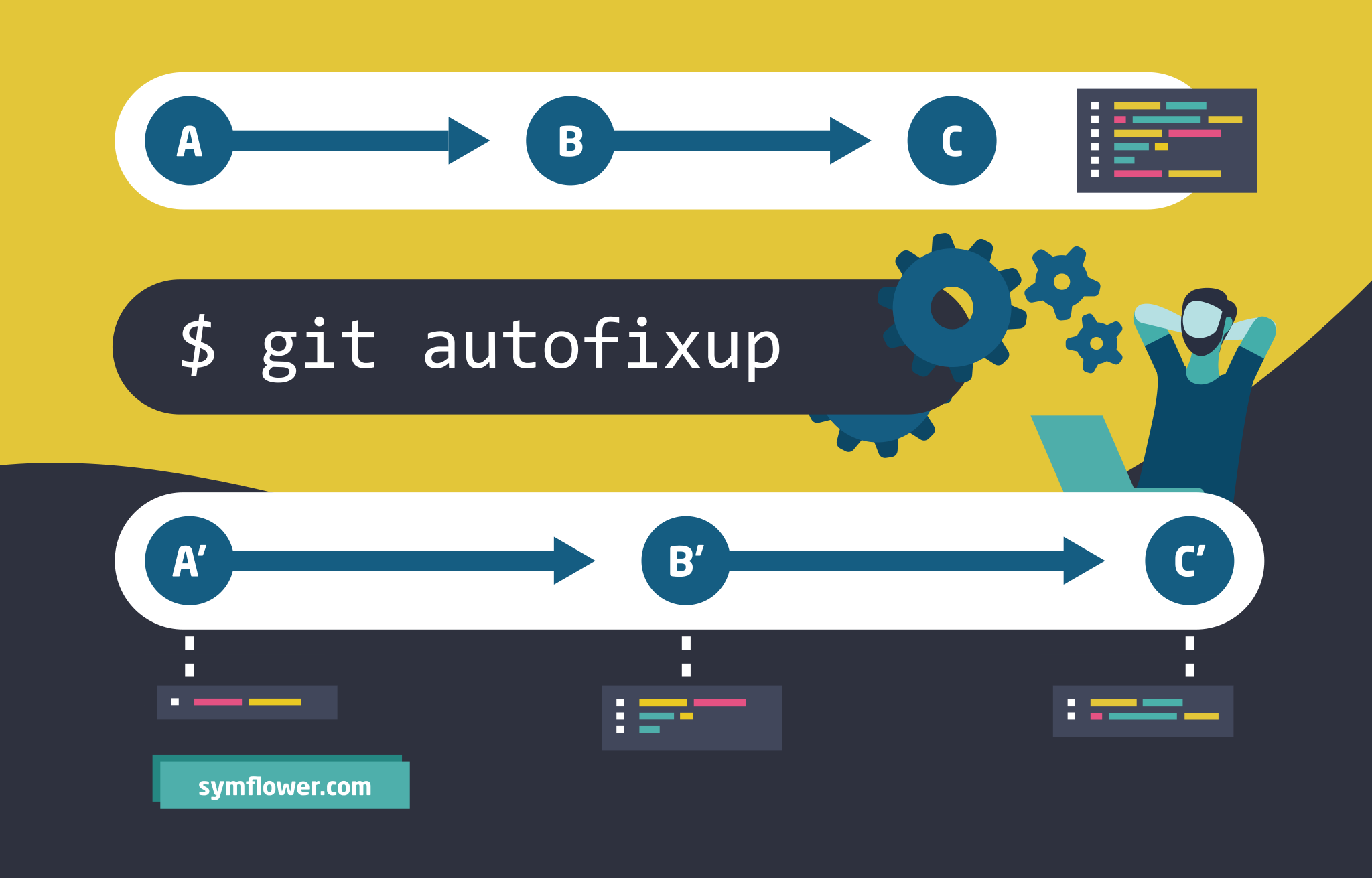
-
Try Symflower for free
Symflower employs deep source code analyses and mathematical models to fully automatically write, run and analyze unit tests, covering all interesting paths through your software programs. These high …

-
How new ways of retrospectives improve the productivity and well-being of your team and company
At Symflower we strive for continuous improvement at all levels and areas. From our point of view this principle is only possible through joint reflection and an open feedback culture throughout the …

-
Interns: the hidden treasures of your summer months
Over the course of my education I (Evelyn Haslinger) did several internships. The disillusioning reality of most of these internships was that I would have spent my summers better off by doing …

-
What are Integer Overflows and how to detect them automatically?
Ariane 5, Boeing’s 787 Dreamliner and a 105-year old swedish lady who has to go to preschool. All these events have one thing in common – they were caused by software errors. Today we show …

-
Hiring and onboarding during the Covid19 lockdown
Since March 16 most of Austria’s companies are obliged to switch to remote work. The transition from on-site work to pure remote work went really smooth for Symflower. Mostly because many of …

-
Symflower is part of the latest campaign of the Austrian Federal Economic Chamber #schaffenwir
The Austrian Federal Economic Chamber (WKO) has launched with #schaffenwir its latest campaign to put a stronger focus on local companies and their employees. From now on Symflower and its team will …
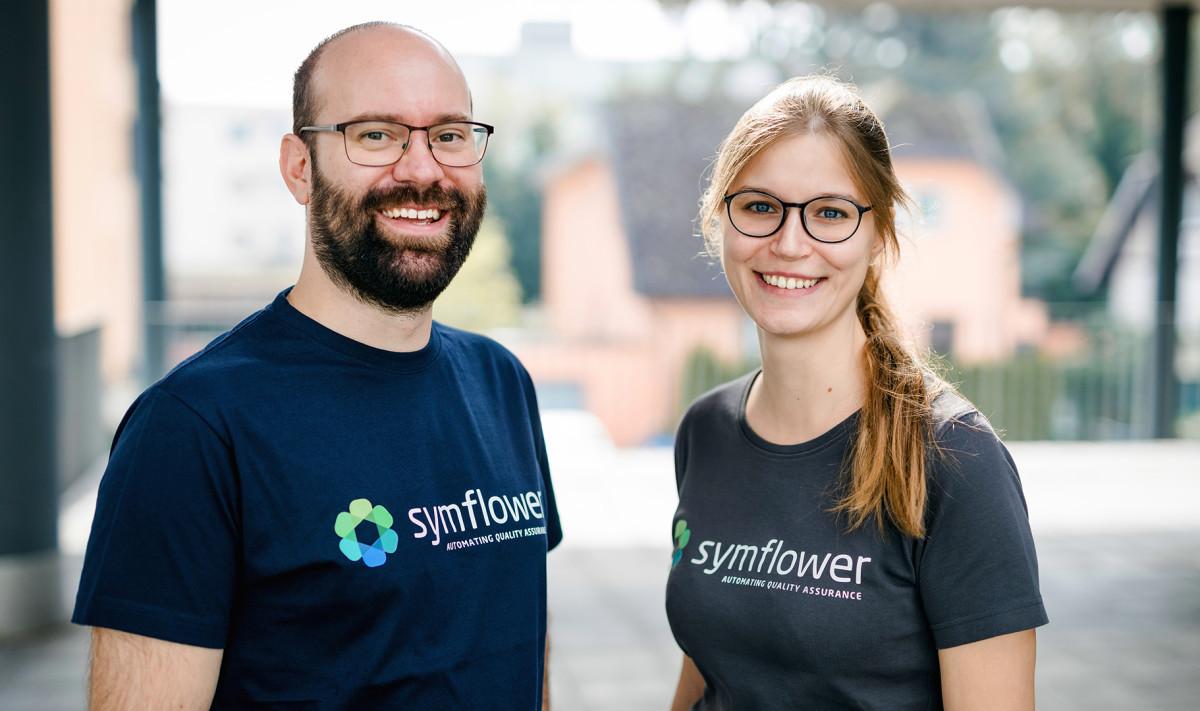
-
Symflower at the Ingram Micro Top 2019
Innovation meets tradition at the Ingram Micro Top. With it’s 17th edition the event has traditional character in the IT industry. Annually the latest innovations are represented in the …
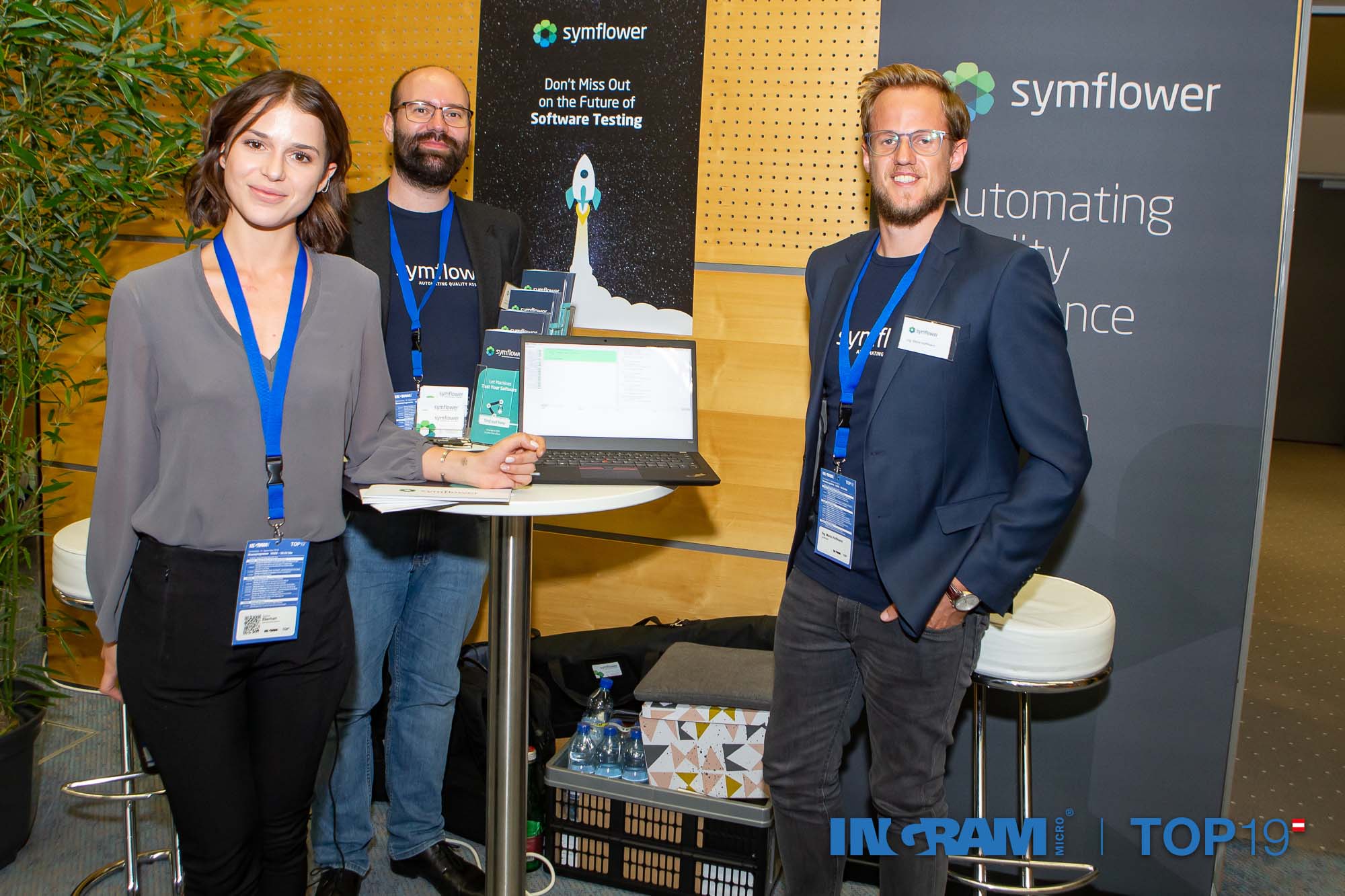
-
Symflower is moving
After 18 months in the Tech2b startup incubator, it is time for us to move to our own office. We really enjoyed our time at Tech2b and we wish our mentors and colleagues all the best. Thank you for …

-
Symflower at the Mobile World Congress 2019 in Barcelona
Symflower looks back at the #MWC19. After 8 weeks we have finished our post-processing and are able to look back on a successful and exciting Mobile World Congress 2019. Let me start by concluding …

-
Symflower's tech2b graduation
Symflower at its tech2b graduation. Startups who have successfully completed their incubation with tech2b are honored in a graduation ceremony. We were honored with the “winner …
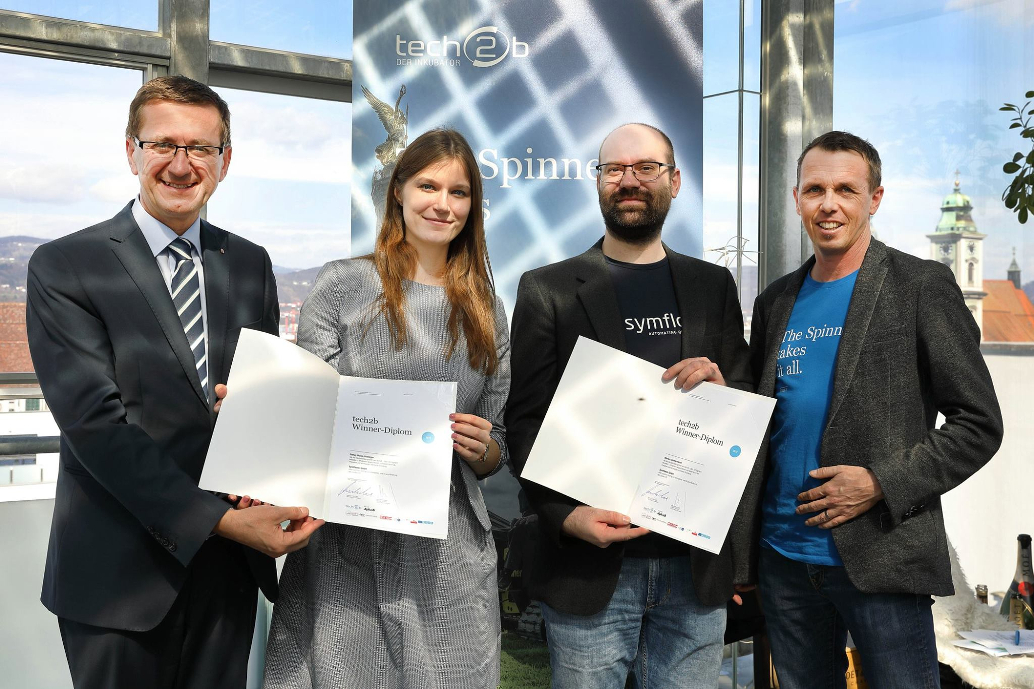
-
TECHCENTER trifft NEUE WERFT - Interview
TECHCENTER meets NEUE WERFT is a (still) young format that regularly conducts interviews with founders of innovative companies. Our co-founder, Evelyn, was interviewed about Symflower as part of this …

-
JKU Founder's Breakfast
We have been invited to introduce Symflower at the Founder’s Breakfast of the Johannes Kepler University Linz. This event took place for the 10th time and attracted numerous visitors. …
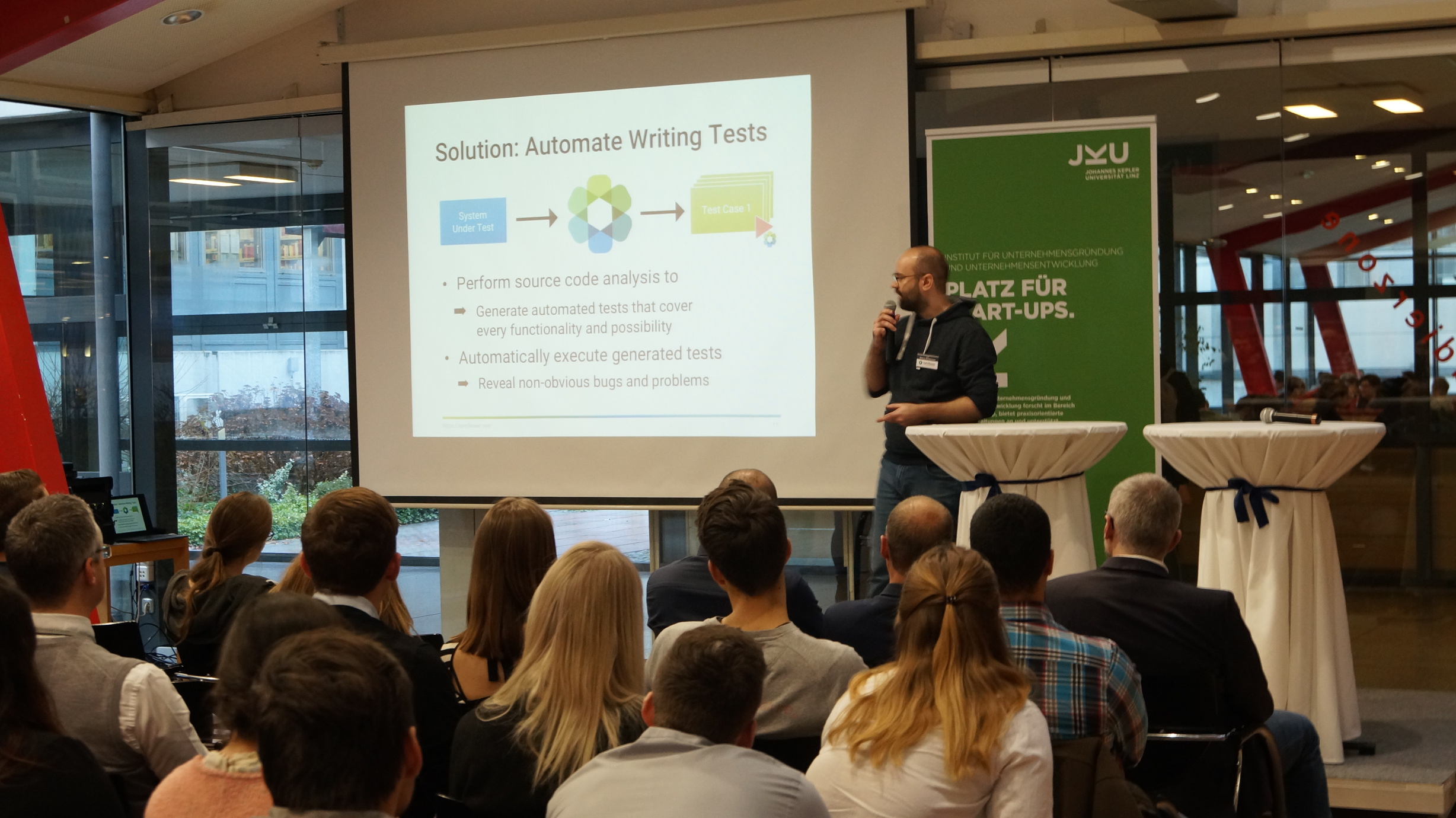
-
IaaM 5 - Kubernetes Talk and Workshop
We held a Kubernetes talk and workshop at the fifth Infrastructure as a Meetup (IaaM). Why Kubernetes?" Kubernetes has become the leading framework for container orchestration, deployment …
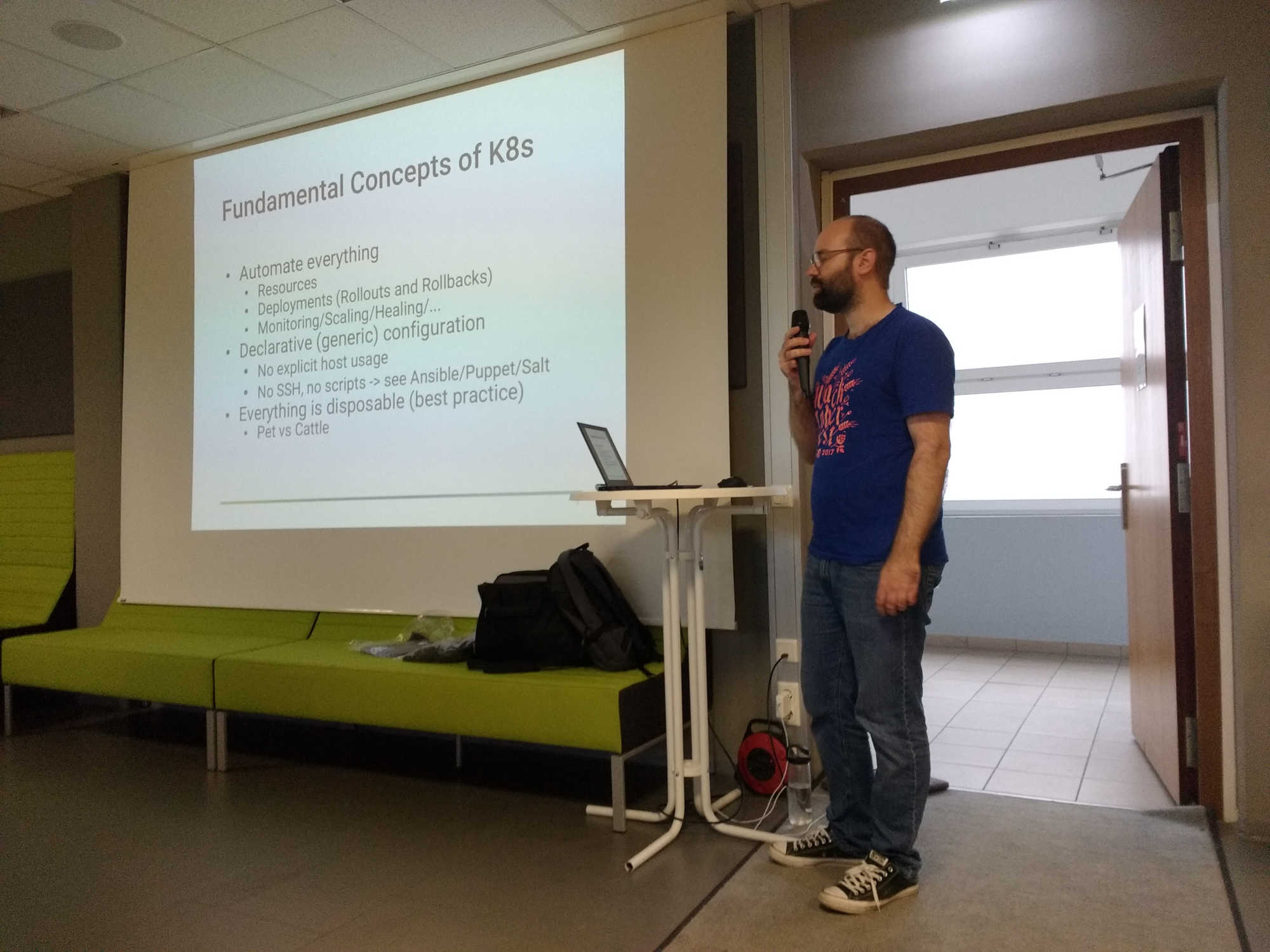
-
i2b Business Plan Competition
We attended the final of the i2b business plan competition of the Austrian-Federal-Economic-Chamber. Only 15 business plans out of 232 entrants received an invitation to the final. We won the shared …
-
Tech2b Scale-up
We got accepted into the tech2b Scale-up program. Tech2b is an incubator in Upper Austria which supports technology- and design-orientated startups. Why Should You Attend? The tech2b funding offers …
-
Edison der Preis of 2017
We attended the final of the Edison der Preis idea contest! Out of 60 entrants only 6 teams were invited for the technical category. Why Should You Attend? Entering the second phase of the contest …



